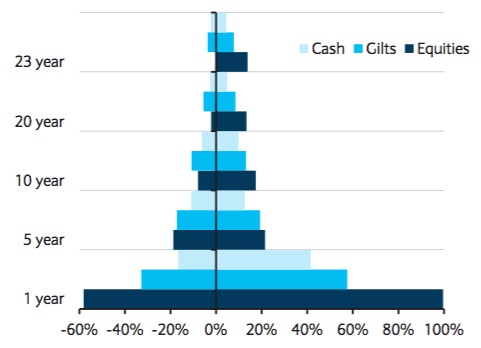Good reads from around the Web.
The best article I read this week was from Carl Richards, writing about diversification for The New York Times.
We often hear how the years from 2000 to 2010 were terrible for investors in shares, even from me.
But in his piece, Richards points out that for a properly diversified investor, there were still good equity returns to be had:
When you view this 10-year period from the perspective of a diversified and balanced portfolio, 2000-2010 was anything but a lost decade.
Consider the following (all numbers reflect annualized returns over 10 years and include reinvested dividends):
U.S. large stocks (the S.&P. 500) = 1.4 percent
U.S. small stocks (the Russell 2000 Index) = 6.3 percent
U.S. real estate stocks (the Dow Jones US REIT index) = 10.4 percent
International stocks (MSCI EAFE Index) = 3.9 percent
Emerging markets stocks (MSCI Emerging Markets Index) = 16.2 percent
Richards suggests that an investor who wanted to be reasonably diversified ten years ago might have simply split their money between these five asset classes. Then they left to compound, without trading or rebalancing or anything else.
The return for this diversified portfolio over the ‘lost decade’ was an annualized 8.35 percent!
Splitting the portfolio 60/40 between equities and bonds reduces the return to 7.83%.
Not a huge difference, and for many people a price well worth paying to reduce the pain of the declines in 2007 and 2008.
From the money blogs
- Dealing with stock market volatility – Oblivious Investor
- 5% rebalancing bands – The Finance Buff
- Market mayhem or golden opportunity? – UK Value Investor
- Investment analysts, sunk by Deepwater Horizon – The Psy-Fi blog
- Making better decisions – iii blog
- How long might retirees live with no remaining money? – Wade Pfau
- The folly of forgetting your investment style – Mon£yGrow£rs
- Post-recession US employment [graphic] – Business Insider
- Finance blog traffic as a contra-indicator – The Big Picture
Deal of the week: You can get 20% off the price of a special leather cover when you buy a new Kindle at Amazon right now
.
Mainstream media money
- Behavioral Finance: Special Report – Bloomberg
- Melbourne now world’s most liveable city – The Economist
- Cash hordes are destroying value in the tech sector – Forbes
- Wall Street’s unemployment machine – The Motley Fool
- No hope for sale of UK bank shares before election – FT
- When does it pay to exit a mortgage early? – FT
- Second home owners forced to cut prices – FT
- Ditch dog funds [and buy index trackers instead!] – FT
- What John Lee has been buying recently – FT
- Post Office extends inflation linked savings account – Telegraph
- Gold fund returns lagging the rising gold price – Telegraph
- Your vegetable patch, their garden – The Guardian
Like these links? Get them every weekend.






Comments on this entry are closed.
I began investing in 1999, pretty much at the beginning of the ‘lost’ decade.
Ironically, investors such as those nearing retirement, who by their nature are more conservative with their portfolios, who invested in developed world large caps suffered more than the young guns with a wanderlust for emerging markets and more exotic sectors.
It was a lost decade for some but by no means everyone. I would say the wealth preservers certainly got pickled.
Thanks for the inclusion in your round up.
Well from 2000 to 2007-ish the lost decade was my experience, with a trusty FTSE all-share index tracker, like you are meant to do. Okay, so I wasn’t losing my shirt as I had up to then chasing momentum, but I think lost decade pretty well sums up many basic index investors’ results.
Only bailing out on late ’07 and going over to the dark side of a HYP from April 09 did that start to change 😉
@ermine — Yes, one beautiful thing about buying well chosen income shares and reinvesting is I think you’re more unlikely to suffer from a ‘lost decade’ compared to a pure index investor (who doesn’t diversify as above) since the yield provides some floor to the share price, an annual return to reinvest, and can also suggest the company/fund is at least fairly-valued, versus over-valued (ceteris paribus!) That said most academics would expect the index fund to catch up and nudge ahead over very long time frames (say 2-3 decades). My jury is out on that.
@moneygrower – I was happily un-invested in 1999, despite following business and the markets (I’ve written about my flukey avoiding of the dotcom burst before). Interesting and sadly probably accurate reflection on the old savers — look at company pension fund deficits as another manifestation of their decade long lament (compounding by expensive and borderline incompetent fund management in many cases, too, of course).
On a reversion-to-mean principle, you’ve got to think the biggest blue chips look well-placed, given this sort of analysis, their low P/Es, generally disdain from everyone, etc.
theres never a lost decade, theres always something that did well, and there will always be someone who nailed it, theres just no way of knowing in advance…
but this fellas suggesting one should have put 20% of their portfolio in emerging markets?
is that really ‘properly’ diversified?
and his bond fund must have done remarkably well to have only pulled things down by about half a percent for a 40% holding?
looks very much like the benefit of hindsight to me
not overly impressed with the article – maybe if he had suggested that 10 years ago and was revisiting his original article…